Abstract
The possible carcinogenicity of cobalt, iron, lead, manganese, mercury, platinum, selenium, and titanium is reviewed, taking into account epidemiological data, the results of animal experimental studies, data on mutagenic effects and on other in vitro test systems. Of the great variety of occupations where exposure to one of these metals may occur, only haematite mining has been clearly shown to involve an increased human cancer risk. While the possibility that haematite might in some way act as a carcinogen has to be taken into consideration it is more likely that other carcinogens are responsible. Certain platinum coordination complexes are used in cancer chemotherapy, are mutagenic, and likely to be carcinogenic. Cobalt, its oxide and sulfide, certain lead salts, one organomanganese, and one organotitanium compound have been shown to have a limited carcinogenic effect in experimental animal studies, and except for titanium appear to be mutagenic. Certain mercury compounds are mutagenic but none have been shown to be carcinogenic. The presently available data are inadequate to assess the possible carcinogenicity of selenium compounds, but a few observations suggest that selenium may suppress the effect of other carcinogens administered to experimental animals and may even be associated with lower cancer mortality rates in man. Epidemiological observations are essential for the assessment of a human cancer risk, but the difficulty in collecting past exposure data in occupational groups and the complexity of multiple occupational exposures with changes over time, limits the usefulness of retrospective epidemiological studies.
Full text
PDF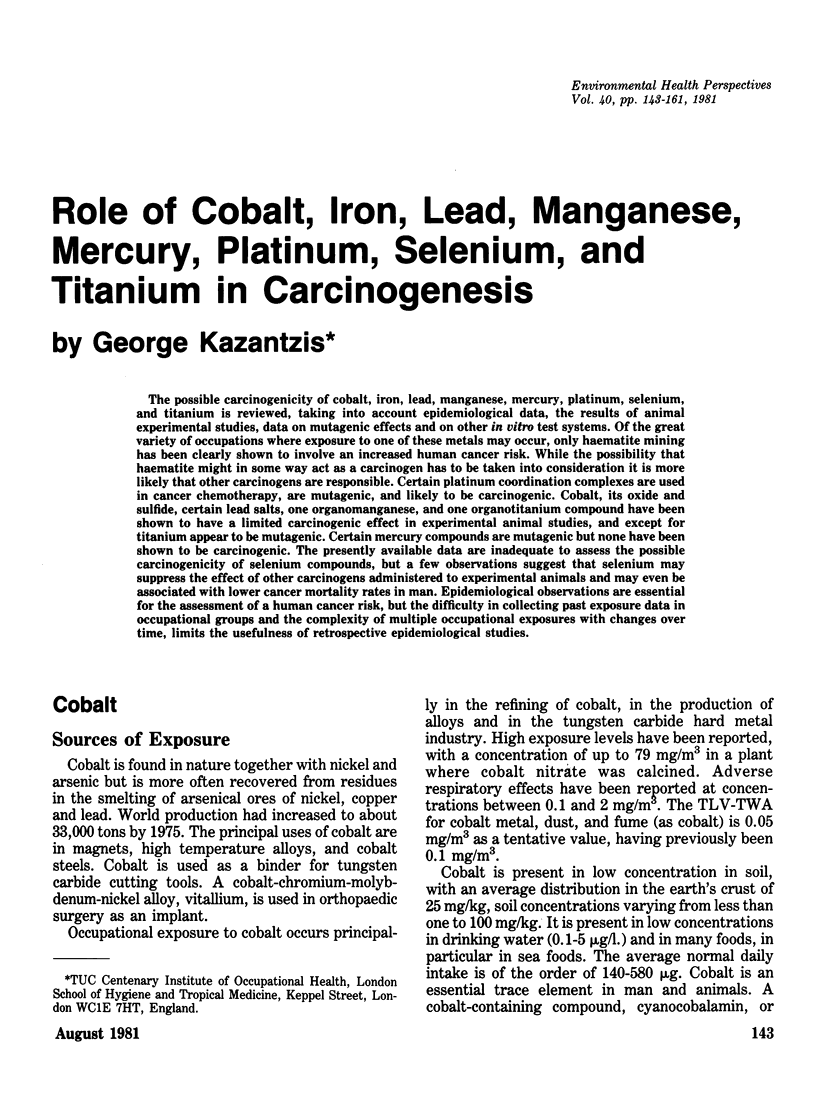
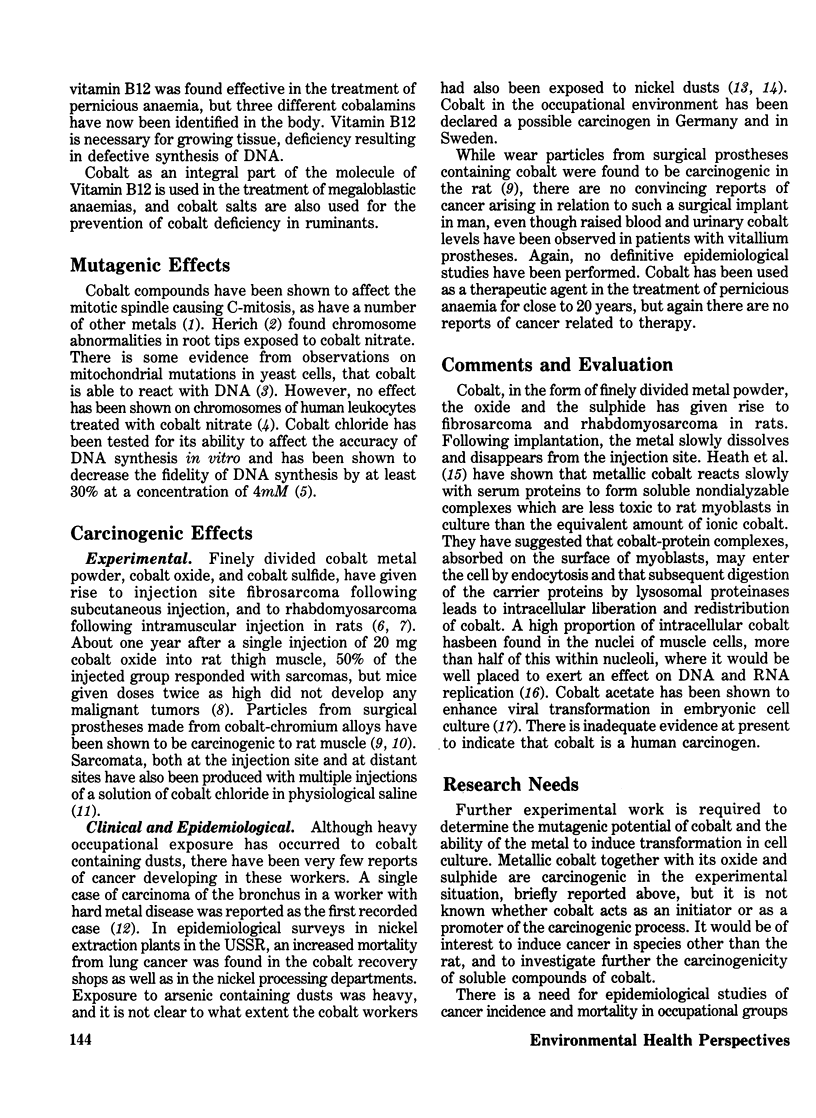

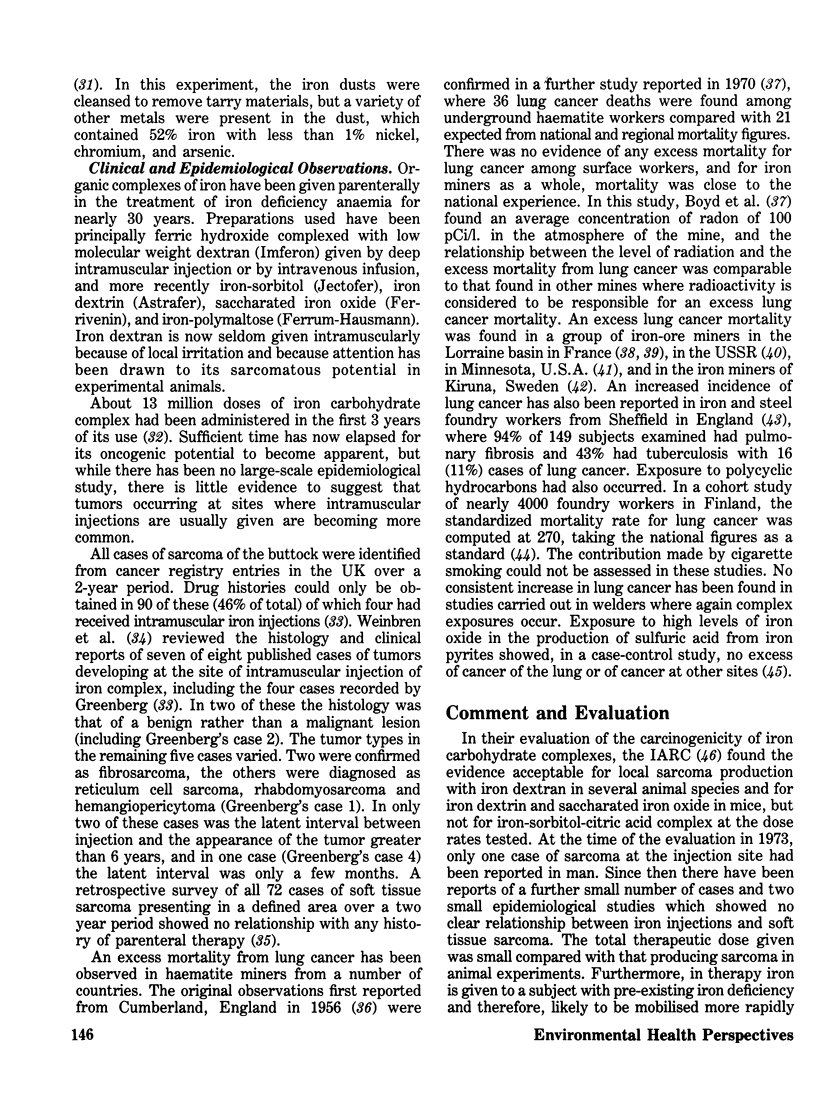
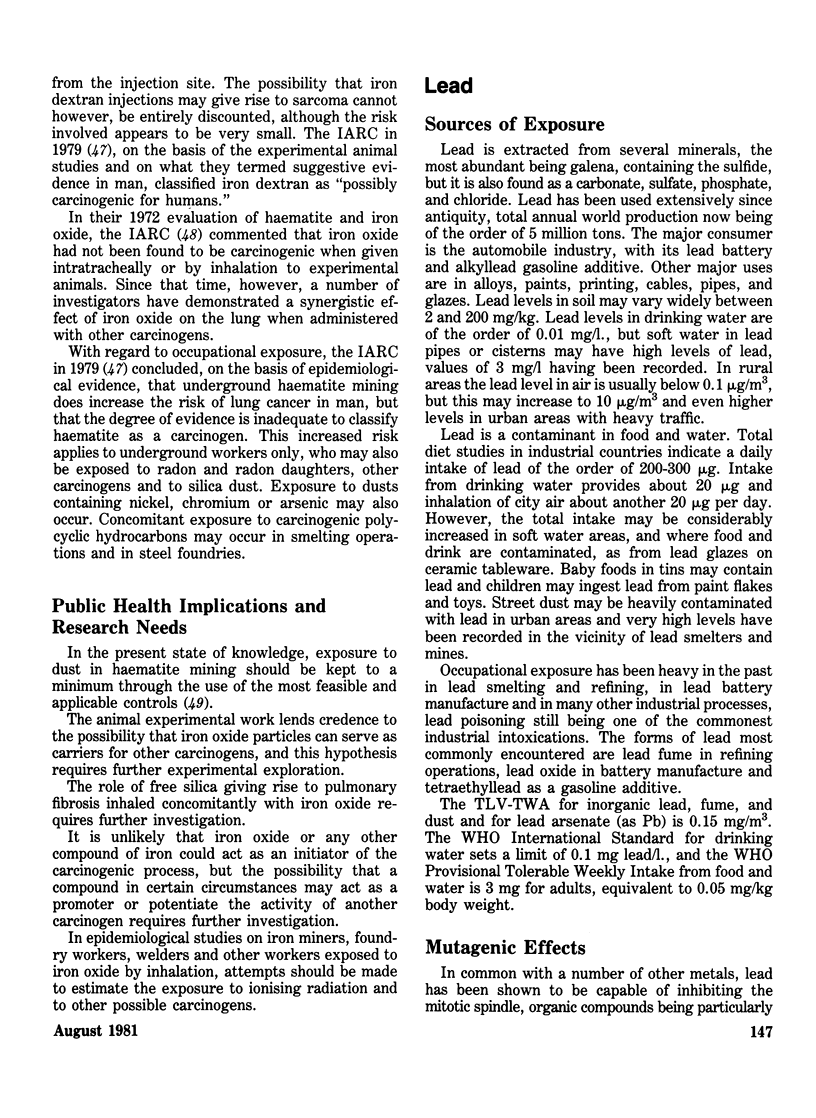
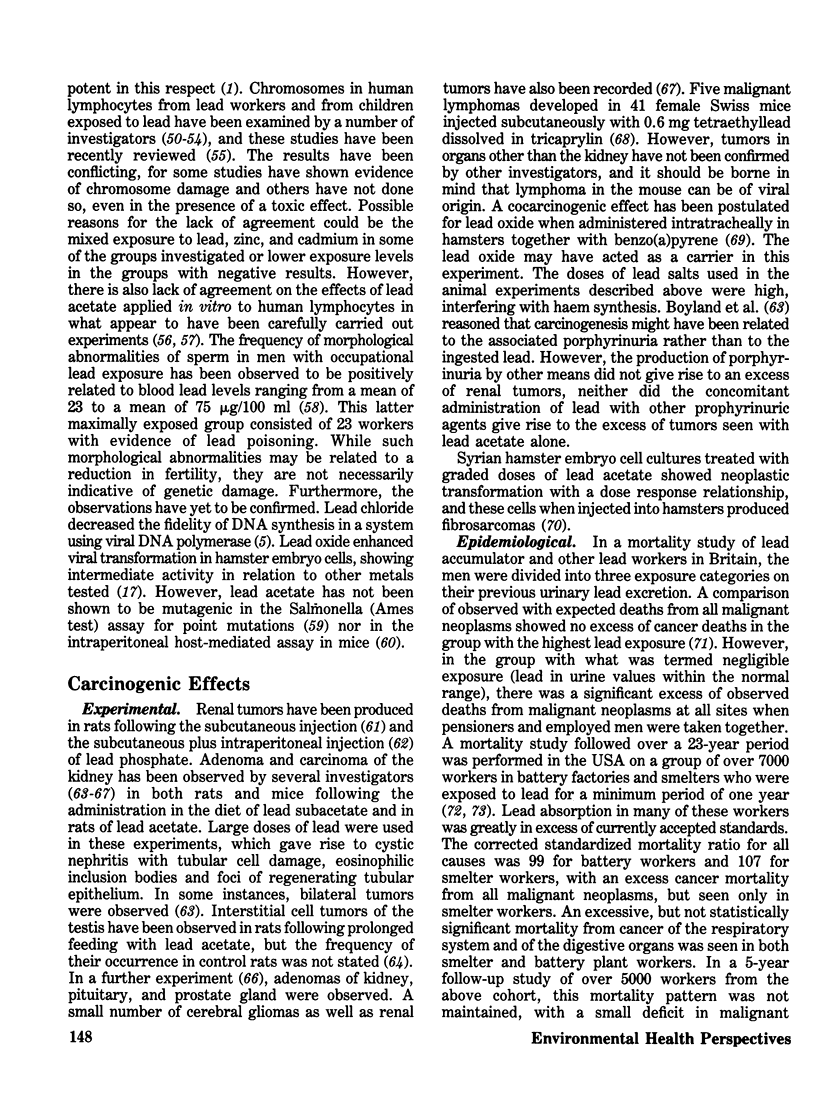
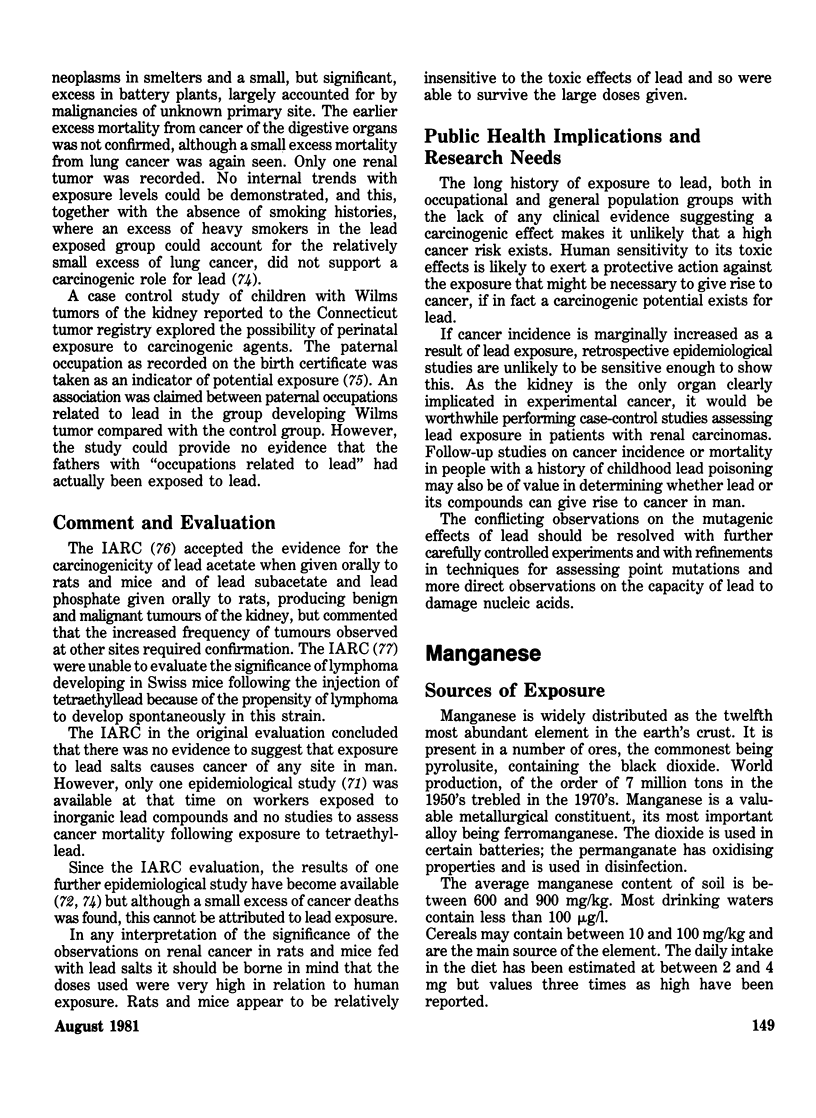
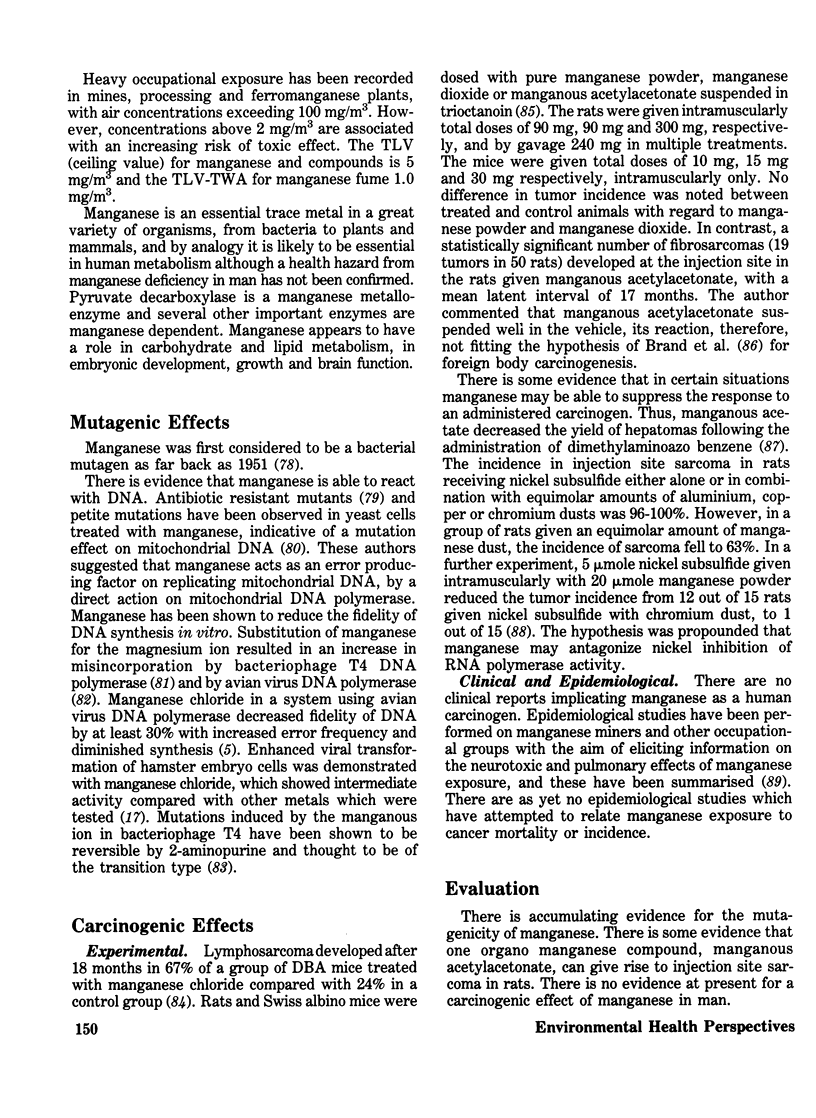
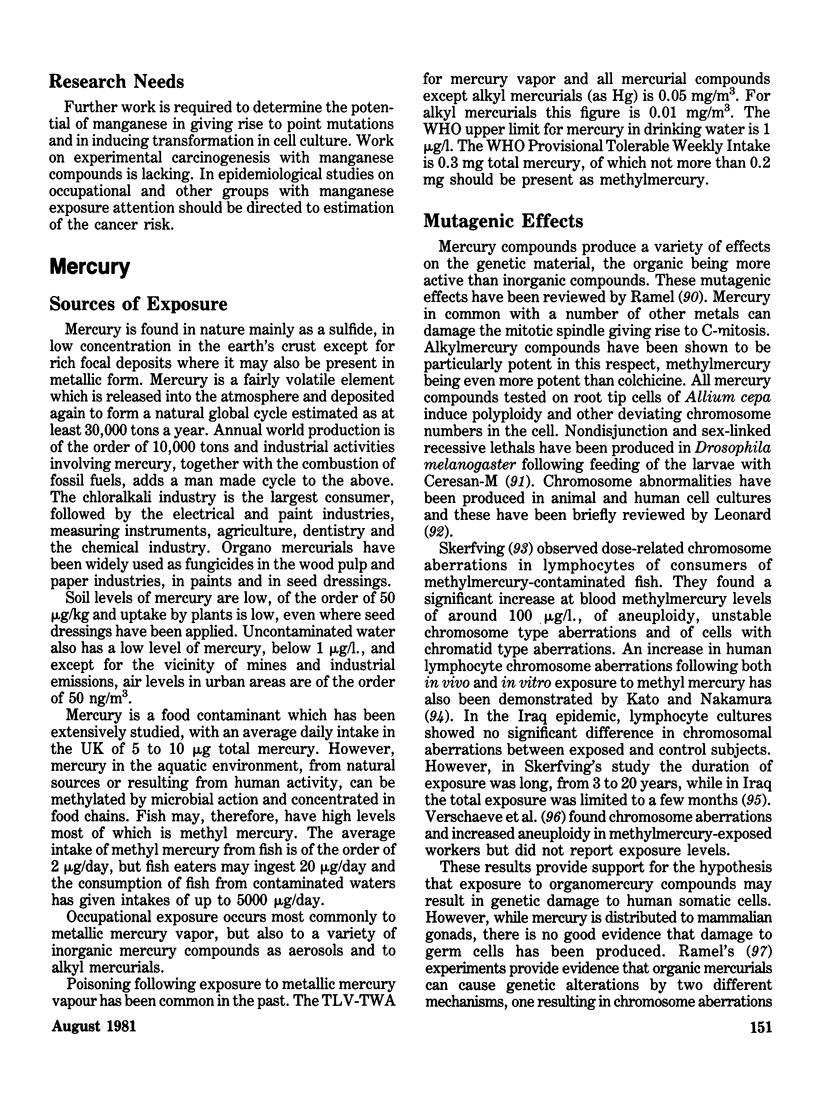
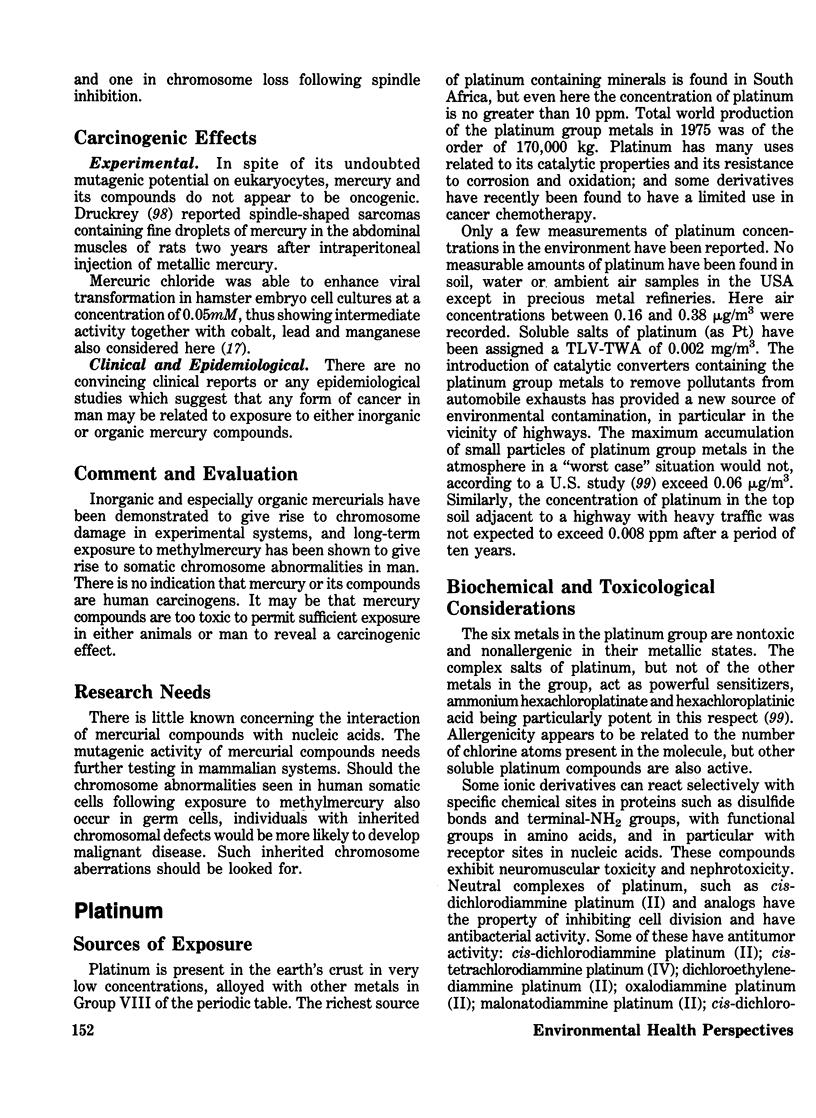

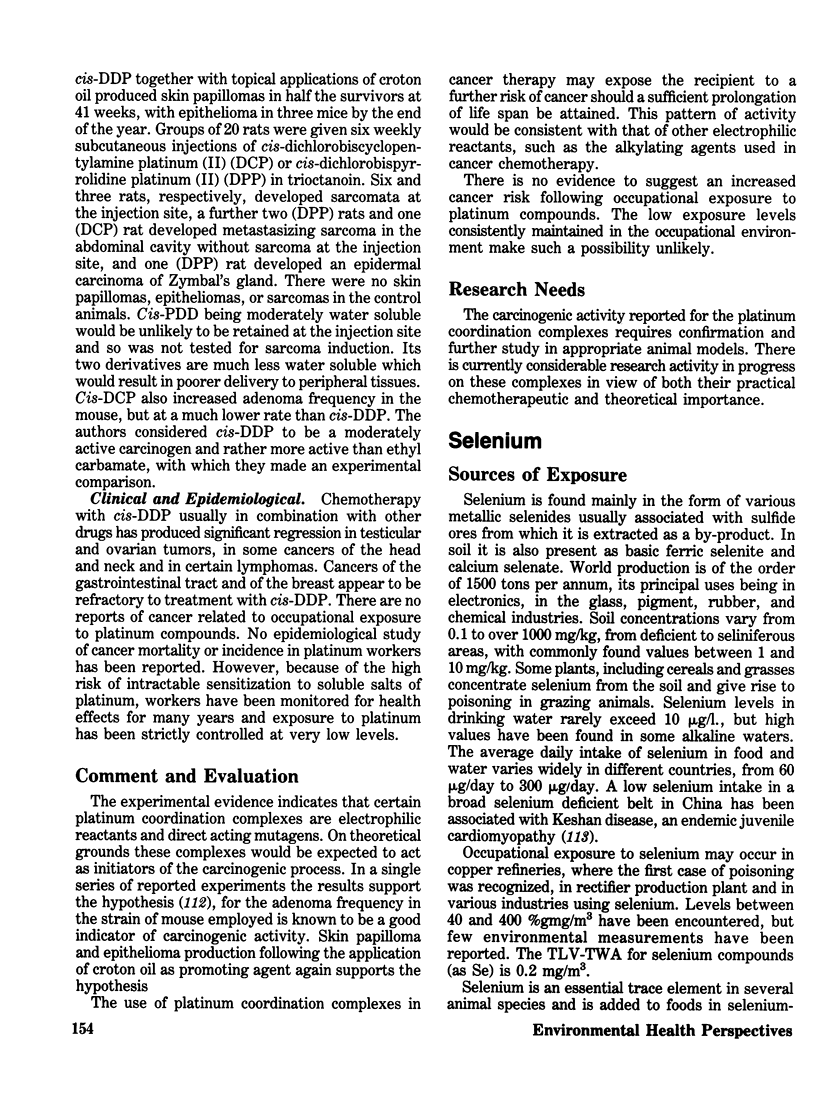
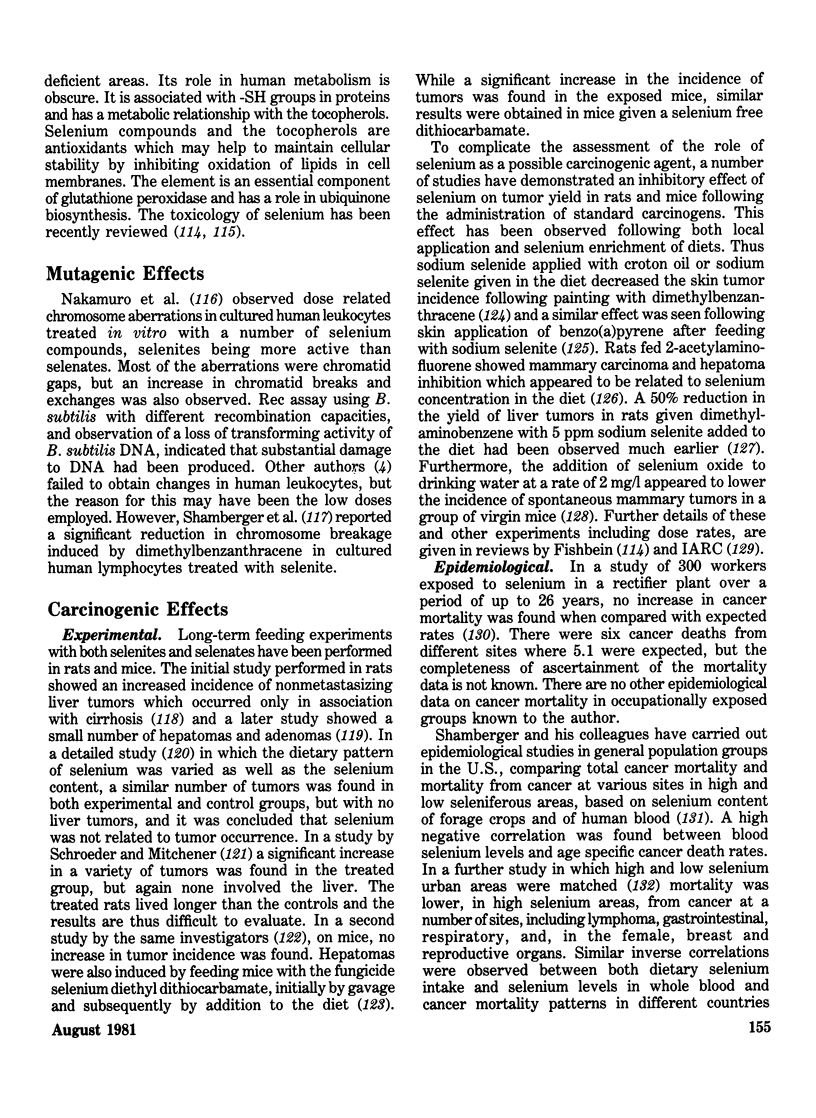
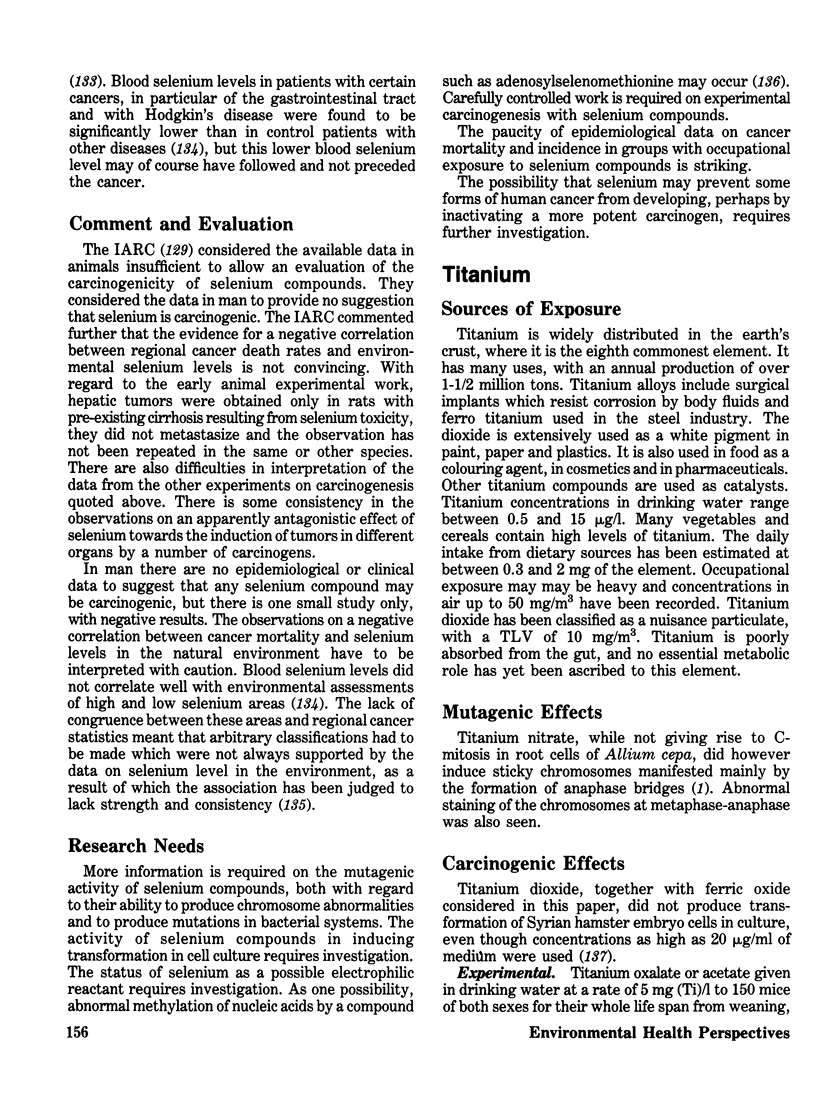

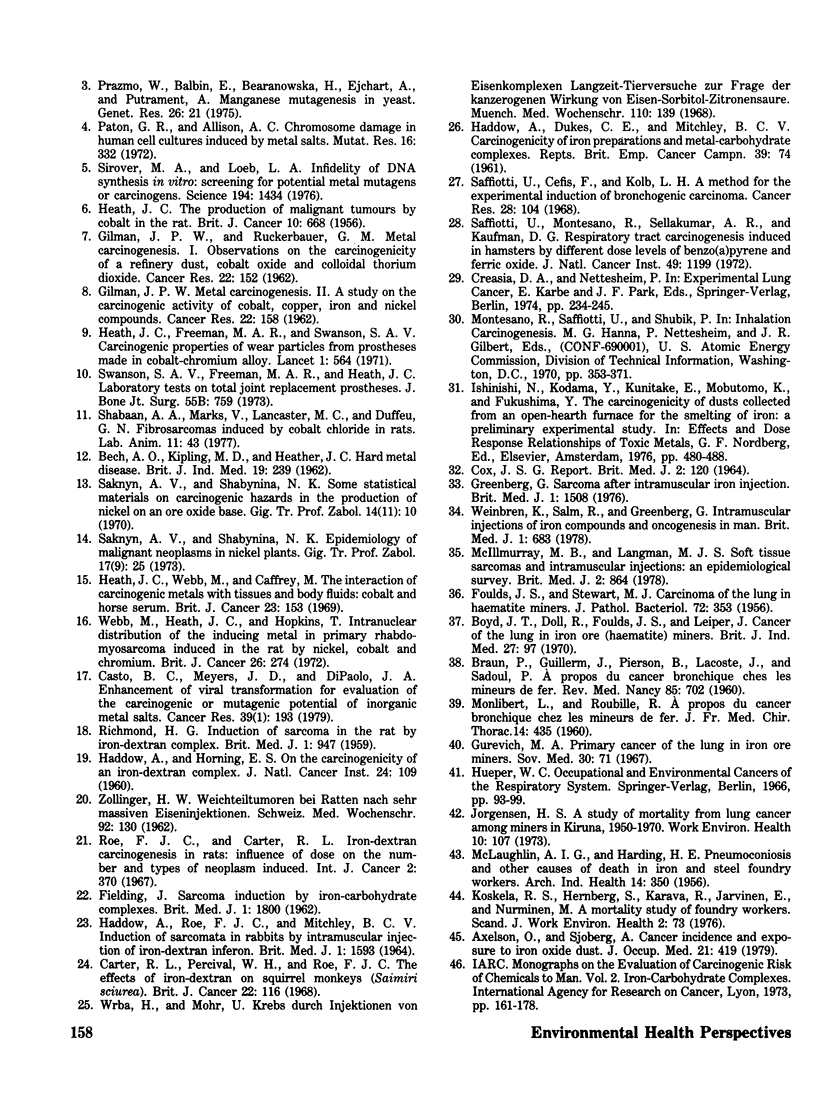
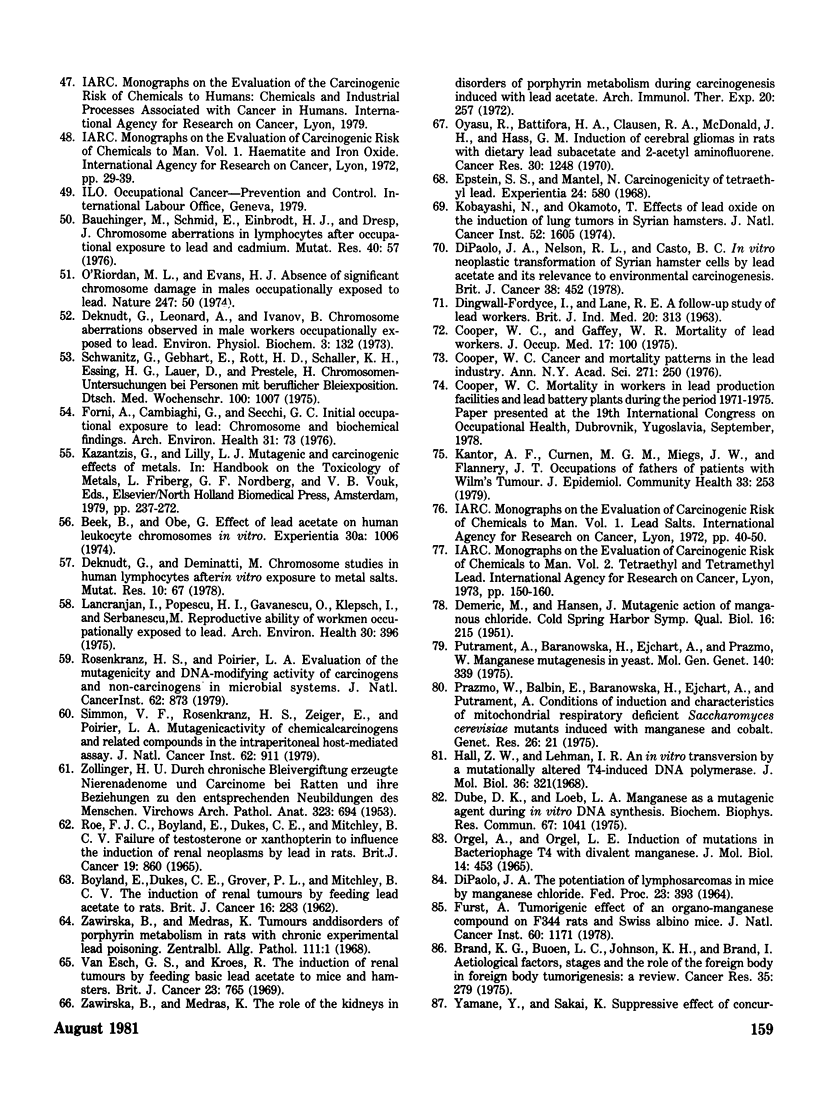
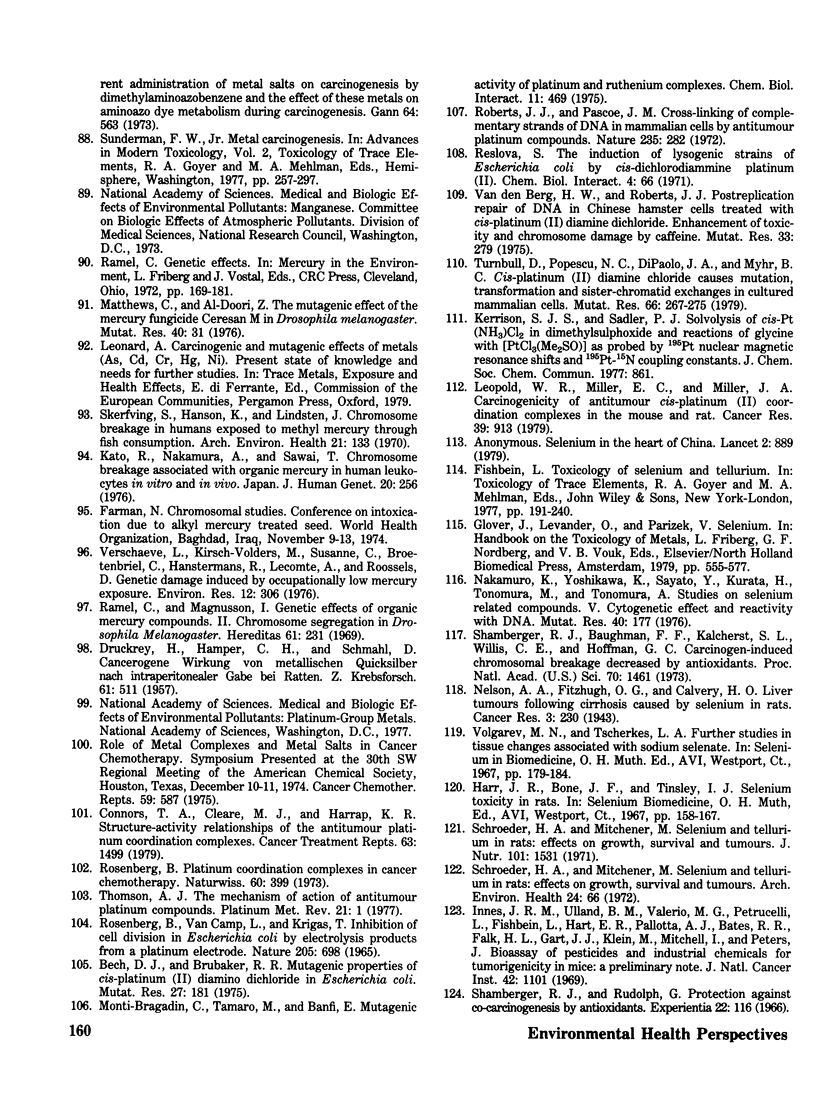

Selected References
These references are in PubMed. This may not be the complete list of references from this article.
- Allaway W. H. An overview of distribution patterns of trace elements in soils and plants. Ann N Y Acad Sci. 1972 Jun 28;199:17–25. doi: 10.1111/j.1749-6632.1972.tb46439.x. [DOI] [PubMed] [Google Scholar]
- Axelson O., Sjöberg A. Cancer incidence and exposure to iron oxide dust. J Occup Med. 1979 Jun;21(6):419–422. [PubMed] [Google Scholar]
- BECH A. O., KIPLING M. D., HEATHER J. C. Hard metal disease. Br J Ind Med. 1962 Oct;19:239–252. doi: 10.1136/oem.19.4.239. [DOI] [PMC free article] [PubMed] [Google Scholar]
- BOYLAND E., DUKES C. E., GROVER P. L., MITCHLEY B. C. The induction of renal tumors by feeding lead acetate to rats. Br J Cancer. 1962 Jun;16:283–288. doi: 10.1038/bjc.1962.33. [DOI] [PMC free article] [PubMed] [Google Scholar]
- Beck D. J., Brubaker R. R. Mutagenic properties of cis-plantinum(II)diammino-dichloride in Escherichia coli. Mutat Res. 1975 Feb;27(2):181–189. doi: 10.1016/0027-5107(75)90077-9. [DOI] [PubMed] [Google Scholar]
- Boyd J. T., Doll R., Faulds J. S., Leiper J. Cancer of the lung in iron ore (haematite) miners. Br J Ind Med. 1970 Apr;27(2):97–105. doi: 10.1136/oem.27.2.97. [DOI] [PMC free article] [PubMed] [Google Scholar]
- Brand K. G., Buoen L. C., Johnson K. H., Brand I. Etiological factors, stages, and the role of the foreign body in foreign body tumorigenesis: a review. Cancer Res. 1975 Feb;35(2):279–286. [PubMed] [Google Scholar]
- Carter R. L., Percival W. H., Roe F. J. The effects of iron-dextran on squirrel monkeys (Saimiri sciurea). Br J Cancer. 1968 Mar;22(1):116–121. doi: 10.1038/bjc.1968.16. [DOI] [PMC free article] [PubMed] [Google Scholar]
- Casto B. C., Meyers J., DiPaolo J. A. Enhancement of viral transformation for evaluation of the carcinogenic or mutagenic potential of inorganic metal salts. Cancer Res. 1979 Jan;39(1):193–198. [PubMed] [Google Scholar]
- Connors T. A., Cleare M. J., Harrap K. R. Structure-activity relationships of the antitumor platinum coordination complexes. Cancer Treat Rep. 1979 Sep-Oct;63(9-10):1499–1502. [PubMed] [Google Scholar]
- Cooper W. C. Cancer mortality patterns in the lead industry. Ann N Y Acad Sci. 1976;271:250–259. doi: 10.1111/j.1749-6632.1976.tb23119.x. [DOI] [PubMed] [Google Scholar]
- Cooper W. C., Gaffey W. R. Mortality of lead workers. J Occup Med. 1975 Feb;17(2):100–107. doi: 10.1097/00043764-197502000-00012. [DOI] [PubMed] [Google Scholar]
- DINGWALL-FORDYCE I., LANE R. E. A FOLLOW-UP STUDY OF LEAD WORKERS. Br J Ind Med. 1963 Oct;20:313–315. doi: 10.1136/oem.20.4.313. [DOI] [PMC free article] [PubMed] [Google Scholar]
- DRUCKREY H., HAMPERL H., SCHMAHL D. Cancerogene Wirkung von metallischem Quecksilber nach intraperitonealer Gabe bei Ratten. Z Krebsforsch. 1957;61(5):511–519. [PubMed] [Google Scholar]
- DiPaolo J. A., Casto B. C. Quantitative studies of in vitro morphological transformation of Syrian hamster cells by inorganic metal salts. Cancer Res. 1979 Mar;39(3):1008–1013. [PubMed] [Google Scholar]
- Dipaolo J. A., Nelson R. L., Casto B. C. In vitro neoplastic transformation of Syrian hamster cells by lead acetate and its relevance to environmental carcinogenesis. Br J Cancer. 1978 Sep;38(3):452–455. doi: 10.1038/bjc.1978.228. [DOI] [PMC free article] [PubMed] [Google Scholar]
- Dube D. K., Loeb L. A. Manganese as a mutagenic agent during in vitro DNA synthesis. Biochem Biophys Res Commun. 1975 Dec 1;67(3):1041–1046. doi: 10.1016/0006-291x(75)90779-2. [DOI] [PubMed] [Google Scholar]
- Epstein S. S., Mantel N. Carcinogenicity of tetraethyl lead. Experientia. 1968 Jun 15;24(6):580–581. doi: 10.1007/BF02153784. [DOI] [PubMed] [Google Scholar]
- FIELDING J. Sarcoma induction by iron-carbohydrate complexes. Br Med J. 1962 Jun 30;1(5295):1800–1803. doi: 10.1136/bmj.1.5295.1800. [DOI] [PMC free article] [PubMed] [Google Scholar]
- Furst A., Haro R. T. A survey of metal carcinogenesis. Prog Exp Tumor Res. 1969;12:102–133. [PubMed] [Google Scholar]
- Furst A. Tumorigenic effect of an organomanganese compound on F344 rats and Swiss albino mice. J Natl Cancer Inst. 1978 May;60(5):1171–1173. doi: 10.1093/jnci/60.5.1171. [DOI] [PubMed] [Google Scholar]
- GILMAN J. P. Metal carcinogenesis. II. A study on the carcinogenic activity of cobalt, copper, iron, and nickel compounds. Cancer Res. 1962 Feb;22:158–162. [PubMed] [Google Scholar]
- GILMAN J. P., RUCKERBAUER G. M. Metal carcinogenesis. I. Observations on the carcinogenicity of a refinery dust, cobalt oxide, and colloidal thorium dioxide. Cancer Res. 1962 Feb;22:152–157. [PubMed] [Google Scholar]
- Glover J. R. Selenium and its industrial toxicology. IMS Ind Med Surg. 1970 Jan;39(1):50–54. [PubMed] [Google Scholar]
- Greenberg G. Sarcoma after intramuscular iron injection. Br Med J. 1976 Jun 19;1(6024):1508–1509. doi: 10.1136/bmj.1.6024.1508-a. [DOI] [PMC free article] [PubMed] [Google Scholar]
- Gurevich M. A. O pervichnom rake legkogo u gornorabochikh zhelezorudnykh shakht. Sov Med. 1967 May;30(5):71–76. [PubMed] [Google Scholar]
- HADDOW A., HORNING E. S. On the carcinogenicity of an iron-dextran complex. J Natl Cancer Inst. 1960 Jan;24:109–147. [PubMed] [Google Scholar]
- HADDOW A., ROE F. J., MITCHLEY B. C. INDUCTION OF SARCOMATA IN RABBITS BY INTRAMUSCULAR INJECTION OF IRON-DEXTRAN ("IMFERON"). Br Med J. 1964 Jun 20;1(5398):1593–1594. doi: 10.1136/bmj.1.5398.1588. [DOI] [PMC free article] [PubMed] [Google Scholar]
- HARDING H. E., MCLAUGHLIN A. I. Pneumoconiosis and other causes of death in iron and steel foundry workers. AMA Arch Ind Health. 1956 Oct;14(4):350–378. [PubMed] [Google Scholar]
- HEATH J. C. The production of malignant tumours by cobalt in the rat. Br J Cancer. 1956 Dec;10(4):668–673. doi: 10.1038/bjc.1956.80. [DOI] [PMC free article] [PubMed] [Google Scholar]
- Hall Z. W., Lehman I. R. An in vitro transversion by a mutationally altered T4-induced DNA polymerase. J Mol Biol. 1968 Sep 28;36(3):321–333. doi: 10.1016/0022-2836(68)90158-7. [DOI] [PubMed] [Google Scholar]
- Harr J. R., Exon J. H., Whanger P. D., Weswig P. H. Effect of dietary selenium on N-2 fluorenyl-acetamide (FAA)-induced cancer in vitamin E supplemented, selenium depleted rats. Clin Toxicol. 1972;5(2):187–194. doi: 10.3109/15563657208990998. [DOI] [PubMed] [Google Scholar]
- Heath J. C., Freeman M. A., Swanson S. A. Carcinogenic properties of wear particles from prostheses made in cobalt-chromium alloy. Lancet. 1971 Mar 20;1(7699):564–566. doi: 10.1016/s0140-6736(71)91162-7. [DOI] [PubMed] [Google Scholar]
- Heath J. C., Webb M., Caffrey M. The interaction of carcinogenic metals with tissues and body fluids. Cobalt and horse serum. Br J Cancer. 1969 Mar;23(1):153–166. doi: 10.1038/bjc.1969.23. [DOI] [PMC free article] [PubMed] [Google Scholar]
- Herich R. The effect of cobalt on the structure of chromosomes and on the mitosis. Chromosoma. 1965;17(2):194–198. doi: 10.1007/BF00330081. [DOI] [PubMed] [Google Scholar]
- Innes J. R., Ulland B. M., Valerio M. G., Petrucelli L., Fishbein L., Hart E. R., Pallotta A. J., Bates R. R., Falk H. L., Gart J. J. Bioassay of pesticides and industrial chemicals for tumorigenicity in mice: a preliminary note. J Natl Cancer Inst. 1969 Jun;42(6):1101–1114. [PubMed] [Google Scholar]
- Kantor A. F., Curnen M. G., Meigs J. W., Flannery J. T. Occupations of fathers of patients with Wilms's tumour. J Epidemiol Community Health. 1979 Dec;33(4):253–256. doi: 10.1136/jech.33.4.253. [DOI] [PMC free article] [PubMed] [Google Scholar]
- Kobayashi N., Okamoto T. Effects of lead oxide on the induction of lung tumors in Syrian hamsters. J Natl Cancer Inst. 1974 May;52(5):1605–1610. doi: 10.1093/jnci/52.5.1605. [DOI] [PubMed] [Google Scholar]
- Koskela R. S., Hernberg S., Kärävä R., Järvinen E., Nurminen M. A mortality study of foundry workers. Scand J Work Environ Health. 1976;2 (Suppl 1):73–89. doi: 10.5271/sjweh.2829. [DOI] [PubMed] [Google Scholar]
- Lancranjan I., Popescu H. I., GAvănescu O., Klepsch I., Serbănescu M. Reproductive ability of workmen occupationally exposed to lead. Arch Environ Health. 1975 Aug;30(8):396–401. doi: 10.1080/00039896.1975.10666733. [DOI] [PubMed] [Google Scholar]
- Leopold W. R., Miller E. C., Miller J. A. Carcinogenicity of antitumor cis-platinum(II) coordination complexes in the mouse and rat. Cancer Res. 1979 Mar;39(3):913–918. [PubMed] [Google Scholar]
- MONLIBERT L., ROUBILLE R. [Apropos of bronchial cancer in an iron miner]. J Fr Med Chir Thorac. 1960;14:435–439. [PubMed] [Google Scholar]
- McIllmurray M. B., Langman M. J. Soft tissue sarcomas and intramuscular injections: an epidemiological survey. Br Med J. 1978 Sep 23;2(6141):864–865. doi: 10.1136/bmj.2.6141.864-a. [DOI] [PMC free article] [PubMed] [Google Scholar]
- Miller J. A., Miller E. C. Natural and synthetic chemical carcinogens in the etiology of cancer. Cancer Res. 1965 Sep;25(8):1292–1304. [PubMed] [Google Scholar]
- Monti-Bragadin C., Tamaro M., Banfi E. Mutagenic activity of platinum and ruthenium complexes. Chem Biol Interact. 1975 Nov;11(5):469–472. doi: 10.1016/0009-2797(75)90014-9. [DOI] [PubMed] [Google Scholar]
- Nakamuro K., Yoshikawa K., Sayato Y., Kurata H., Tonomura M. Studies on selenium-related compounds. V. Cytogenetic effect and reactivity with DNA. Mutat Res. 1976 Jul;40(3):177–184. doi: 10.1016/0165-1218(76)90042-2. [DOI] [PubMed] [Google Scholar]
- Orgel A., Orgel L. E. Induction of mutations in bacteriophage T4 with divalent manganese. J Mol Biol. 1965 Dec;14(2):453–457. doi: 10.1016/s0022-2836(65)80195-4. [DOI] [PubMed] [Google Scholar]
- Oyasu R., Battifora H. A., Clasen R. A., McDonald J. H., Hass G. M. Induction of cerebral gliomas in rats with dietary lead subacetate and 2-acetylaminofluorene. Cancer Res. 1970 May;30(5):1248–1261. [PubMed] [Google Scholar]
- Paton G. R., Allison A. C. Chromosome damage in human cell cultures induced by metal salts. Mutat Res. 1972 Nov;16(3):332–336. doi: 10.1016/0027-5107(72)90166-2. [DOI] [PubMed] [Google Scholar]
- Putrament A., Baranowska H., Ejchart A., Prazmo W. Manganese mutagenesis in yeast. IV. The effects of magnesium, protein synthesis inhibitors and hydroxyurea on AntR induction in mitochondrial DNA. Mol Gen Genet. 1975 Oct 22;140(4):339–347. [PubMed] [Google Scholar]
- RICHMOND H. G. Induction of sarcoma in the rat by iron-dextran complex. Br Med J. 1959 Apr 11;1(5127):947–949. doi: 10.1136/bmj.1.5127.947. [DOI] [PMC free article] [PubMed] [Google Scholar]
- ROSENBERG B., VANCAMP L., KRIGAS T. INHIBITION OF CELL DIVISION IN ESCHERICHIA COLI BY ELECTROLYSIS PRODUCTS FROM A PLATINUM ELECTRODE. Nature. 1965 Feb 13;205:698–699. doi: 10.1038/205698a0. [DOI] [PubMed] [Google Scholar]
- Ramel C., Magnusson J. Genetic effects of organic mercury compounds. II. Chromosome segregation in Drosophila melanogaster. Hereditas. 1969;61(1):231–254. [PubMed] [Google Scholar]
- Reslová S. The induction of lysogenic strains of Escherichia coli by cis-dichloro-diammineplatinum (II). Chem Biol Interact. 1971 Dec;4(1):66–70. doi: 10.1016/0009-2797(71)90034-2. [DOI] [PubMed] [Google Scholar]
- Roberts J. J., Pascoe J. M. Cross-linking of complementary strands of DNA in mammalian cells by antitumour platinum compounds. Nature. 1972 Feb 4;235(5336):282–284. doi: 10.1038/235282a0. [DOI] [PubMed] [Google Scholar]
- Roe F. J., Boyland E., Dukes C. E., Mitchley B. C. Failure of testosterone or xanthopterin to influence the induction of renal neoplasms by lead in rats. Br J Cancer. 1965 Dec;19(4):860–866. doi: 10.1038/bjc.1965.99. [DOI] [PMC free article] [PubMed] [Google Scholar]
- Roe F. J., Carter R. L. Iron-dextran carcinogenesis in rats: influence of dose on the number and types of neoplasm induced. Int J Cancer. 1967 Jul 15;2(4):370–380. doi: 10.1002/ijc.2910020412. [DOI] [PubMed] [Google Scholar]
- Rosenberg B. Platinum coordination complexes in cancer chemotherapy. Naturwissenschaften. 1973 Sep;60(9):399–406. doi: 10.1007/BF00623551. [DOI] [PubMed] [Google Scholar]
- Rosenkranz H. S., Poirier L. A. Evaluation of the mutagenicity and DNA-modifying activity of carcinogens and noncarcinogens in microbial systems. J Natl Cancer Inst. 1979 Apr;62(4):873–892. [PubMed] [Google Scholar]
- SCHROEDER H. A., BALASSA J. J., VINTON W. H., Jr CHROMIUM, LEAD, CADMIUM, NICKEL AND TITANIUM IN MICE: EFFECT ON MORTALITY, TUMORS AND TISSUE LEVELS. J Nutr. 1964 Jul;83:239–250. doi: 10.1093/jn/83.3.239. [DOI] [PubMed] [Google Scholar]
- Saffiotti U., Cefis F., Kolb L. H. A method for the experimental induction of bronchogenic carcinoma. Cancer Res. 1968 Jan;28(1):104–124. [PubMed] [Google Scholar]
- Saffiotti U., Montesano R., Sellakumar A. R., Kaufman D. G. Respiratory tract carcinogenesis induced in hamsters by different dose levels of benzo-(a)pyrene and ferric oxide. J Natl Cancer Inst. 1972 Oct;49(4):1199–1204. [PubMed] [Google Scholar]
- Saknyn' A. V., Shabynina N. K. Epidemiologiia zlokachestvennykh novoobrazovanii na nikelevykh predpriiatiiakh. Gig Tr Prof Zabol. 1973 Sep;17(9):25–29. [PubMed] [Google Scholar]
- Saknyn' A. V., Shabynina N. K. Nekotorye statisticheskie materialy o kantserogennoi opasnosti v proizvodstve nikelia na baze okislennykh rud. Gig Tr Prof Zabol. 1970 Nov;14(11):10–13. [PubMed] [Google Scholar]
- Schrauzer G. N., Ishmael D. Effects of selenium and of arsenic on the genesis of spontaneous mammary tumors in inbred C3H mice. Ann Clin Lab Sci. 1974 Nov-Dec;4(6):441–447. [PubMed] [Google Scholar]
- Schrauzer G. N., White D. A., Schneider C. J. Cancer mortality correlation studies--III: statistical associations with dietary selenium intakes. Bioinorg Chem. 1977;7(1):23–31. doi: 10.1016/s0006-3061(00)80126-x. [DOI] [PubMed] [Google Scholar]
- Schroeder H. A., Mitchener M. Selenium and tellurium in mice. Effects on growth, survival, and tumors. Arch Environ Health. 1972 Jan;24(1):66–71. doi: 10.1080/00039896.1972.10666052. [DOI] [PubMed] [Google Scholar]
- Schroeder H. A., Mitchener M. Selenium and tellurium in rats: effect on growth, survival and tumors. J Nutr. 1971 Nov;101(11):1531–1540. doi: 10.1093/jn/101.11.1531. [DOI] [PubMed] [Google Scholar]
- Schwanitz G., Gebhart E., Rott H. D., Schaller K. H., Essing H. G., Lauer O., Prestele H. Chromosomenuntersuchungen bei Personen mit beruflicher Bleiexposition. Dtsch Med Wochenschr. 1975 May 2;100(18):1007–1011. doi: 10.1055/s-0028-1106327. [DOI] [PubMed] [Google Scholar]
- Shabaan A. A., Marks V., Lancaster M. C., Dufeu G. N. Fibrosarcomas induced by cobalt chloride (CoCl2) in rats. Lab Anim. 1977 Jan;11(1):43–46. doi: 10.1258/002367777780959157. [DOI] [PubMed] [Google Scholar]
- Shamberger R. J., Baughman F. F., Kalchert S. L., Willis C. S., Hoffman G. C. Carcinogen-induced chromosomal breakage decreased by antioxidants. Proc Natl Acad Sci U S A. 1973 May;70(5):1461–1463. doi: 10.1073/pnas.70.5.1461. [DOI] [PMC free article] [PubMed] [Google Scholar]
- Shamberger R. J., Frost D. V. Possible protective effect of selenium against human cancer. Can Med Assoc J. 1969 Apr 12;100(14):682–682. [PMC free article] [PubMed] [Google Scholar]
- Shamberger R. J. Relationship of selenium to cancer. I. Inhibitory effect of selenium on carcinogenesis. J Natl Cancer Inst. 1970 Apr;44(4):931–936. [PubMed] [Google Scholar]
- Shamberger R. J., Rudolph G. Protection against cocarcinogenesis by antioxidants. Experientia. 1966 Feb 15;22(2):116–116. doi: 10.1007/BF01900187. [DOI] [PubMed] [Google Scholar]
- Shamberger R. J., Willis C. E. Selenium distribution and human cancer mortality. CRC Crit Rev Clin Lab Sci. 1971 Jun;2(2):211–221. doi: 10.3109/10408367109151308. [DOI] [PubMed] [Google Scholar]
- Simmon V. F., Rosenkranz H. S., Zeiger E., Poirier L. A. Mutagenic activity of chemical carcinogens and related compounds in the intraperitoneal host-mediated assay. J Natl Cancer Inst. 1979 Apr;62(4):911–918. [PubMed] [Google Scholar]
- Sirover M. A., Loeb L. A. Infidelity of DNA synthesis in vitro: screening for potential metal mutagens or carcinogens. Science. 1976 Dec 24;194(4272):1434–1436. doi: 10.1126/science.1006310. [DOI] [PubMed] [Google Scholar]
- Skerfving S., Hansson K., Lindsten J. Chromosome breakage in humans exposed to methyl mercury through fish consumption. Preliminary communication. Arch Environ Health. 1970 Aug;21(2):133–139. doi: 10.1080/00039896.1970.10667210. [DOI] [PubMed] [Google Scholar]
- Swanson S. A., Freeman M. A., Heath J. C. Laboratory tests on total joint replacement prostheses. J Bone Joint Surg Br. 1973 Nov;55(4):759–773. [PubMed] [Google Scholar]
- Turnbull D., Popescu N. C., DiPaolo J. A., Myhr B. C. Cis-platinum(II) diamine dichloride causes mutation, transformation, and sister-chromatid exchanges in cultured mammalian cells. Mutat Res. 1979 Mar;66(3):267–275. doi: 10.1016/0165-1218(79)90088-0. [DOI] [PubMed] [Google Scholar]
- Van Den Berg H. W., Roberts J. J. Post-replication repair of DNA in Chinese hamster cells treated with cis platinum (II) diamine dichloride. Enhancement of toxicity and chromosome damage by caffeine. Mutat Res. 1975 Dec;33(2-3):279–284. doi: 10.1016/0027-5107(75)90203-1. [DOI] [PubMed] [Google Scholar]
- Van Esch G. J., Kroes R. The induction of renal tumours by feeding basic lead acetate to mice and hamsters. Br J Cancer. 1969 Dec;23(4):765–771. doi: 10.1038/bjc.1969.95. [DOI] [PMC free article] [PubMed] [Google Scholar]
- Verschaeve L., Kirsch-Volders M., Susanne C., Groetenbriel C., Haustermans R., Lecomte A., Roossels D. Genetic damage induced by occupationally low mercury exposure. Environ Res. 1976 Dec;12(3):306–316. doi: 10.1016/0013-9351(76)90040-2. [DOI] [PubMed] [Google Scholar]
- Webb M., Heath J. C., Hopkins T. Intranuclear distribution of the inducing metal in primary rhabdomyosarcomata induced in the rat by nickel, cobalt and cadmium. Br J Cancer. 1972 Aug;26(4):274–278. doi: 10.1038/bjc.1972.37. [DOI] [PMC free article] [PubMed] [Google Scholar]
- Weinbren K., Salm R., Greenberg G. Intramuscular injections of iron compounds and oncogenesis in man. Br Med J. 1978 Mar 18;1(6114):683–685. doi: 10.1136/bmj.1.6114.683. [DOI] [PMC free article] [PubMed] [Google Scholar]
- ZOLLINGER H. U. Durch chronische Bleivergiftung erzeugte Nierenadenome und -carcinome bei Ratten und ihre Beziehungen zu den entsprechenden Neubildungen des Menschen. Virchows Arch Pathol Anat Physiol Klin Med. 1953;323(6):694–710. doi: 10.1007/BF00956266. [DOI] [PubMed] [Google Scholar]
- Zawirska B., Medraś K. The role of the kidneys in disorders of porphyrin metabolism during carcinogenesis induced with lead acetate. Arch Immunol Ther Exp (Warsz) 1972;20(2):257–272. [PubMed] [Google Scholar]


